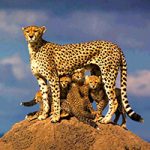HYDRATION ON KILIMANJARO
The acclimatization process requires copious amounts of water consumption. Therefore, while climbing Kilimanjaro, it is necessary for participants to have the ability to carry lots of water. Drinking plenty of water is one of the main ways to combat altitude sickness symptoms so you definitely want to stay well hydrated throughout the climb.
Four to five liters is the daily recommended water consumption.
Water On The Mountain
During your climb all drinking water is collected by our porters from streams that are fed from glaciers high on Kilimanjaro. Before being served all the water is boiled then placed through a sieve to remove any large particles. We provide you with 4 liters of boiled water per day for drinking only.

Due to environmental reasons “ Leave No Trace” – we will not carry any purchased bottled water. If you wish to treat the water further we ask that you bring any additional treatment products with you as these will not be supplied by KCC.
Dehydration
You can easily become dehydrated at high altitudes!
The lower air pressure forces you to breathe more quickly and deeply, and you lose a lot of water through your lungs. You will also be exerting yourself, and sweating, and may even suffer from diarrhoea. As a result, you’ll have to drink much more water than you normally would so you should drink at least 3 litres of fluids every day while climbing.
Even when you don’t feel thirsty you have to drink this amount as a minimum – preferably more. This is particularly important on the final day when you attempt the summit and could mean the difference between success or failure.
Stay on the look-out for signs of dehydration in yourself and your fellow climbers. The most common symptoms include thirst, dry lips, nose or mouth, headache and feeling fatigued or lethargic.
How to Carry Your Water
Our gear list includes BOTH a water bladder, such as a 3 liter CamelBak or Platypus, and a water bottle, such as a 1 liter Nalgene. Water bladders are also known as hydration bladders or reservoirs.
WATER BLADDERS
A water bladder is useful for many reasons

Make sure your water bladder has an insulated hose to help avoid the water freezing in the drinking tube
- High capacity: the bladders come in various sizes which allow you to carry a large supply of water.
- Hands-free operation: all you need to do is bite down on the valve to drink. No need to open and close anything
- Encourages consistent hydration: because there is no need to stop to drink, climbers can consume water by consistent sipping rather than gulping periodically.
WATER BOTTLES
We also require water bottles for a few good reasons
- Extra capacity: our recommended water intake is 4-5 liters. So the addition of a water bottle will add to the capacity of the water bladder for a total of four liters of water.
- Used on summit night: due to cold temperatures, a water bladder often fails due to the hose or valve freezing over. A water bottle, carried upside down in your pack, will allow for you to continue drinking (the bottom of the bottle may form ice).
- Electrolytes we encourage the use of electrolytes during your climb. The water bottle can serve as the designated place to mix in electrolyte powder while keeping the water bladder filled with water only. This will stop the electrolyte taste from seeping into the bladder. Also, so you can prepare small amounts of electrolyte drink at a time.
Drink Water
First of all, listen to your guide at the trip briefing and each night as he prepares you for the next day. He will tell you how much water to bring in your hydration bladder and water bottle. Secondly, drink the water as you hike. This is easier said than done but drink frequently. Our guides will instruct you to throughout the day. Listen to them and drink when reminded.
Drink plenty of water in camp
By drinking plenty of fluids both while hiking and at camp, your body will acclimate to the elevation increase much easier. When you are dehydrated, it causes your body to work harder and that will make it more difficult to adapt to the altitude.
What to Use on Summit Night
We recommend bringing your bladder PLUS a water bottle/ nalgene inside your pack. Most people do not consume much water on the way up because it is very cold, but your guide will stop you a 3-4 times to remind you to drink water. Exposed water bottles will freeze. Our guides will fill your bottles with hot water which you should then store in your backpack.
KCC Tips
Water Bladders – Start the summit bid by using the bladder. Drink as often as you can to keep the flow of water. If the tube / bite starts to freeze, blow back into it after every drink to emove excess water from the tube. If it does freeze you can then use your back up water bottles. Once the sun rises and it warms up your bladder tube will become functional again.
Water Bottles – Store the bottles upside down in your back pack. Water freezes from the top down. A water bottle, carried upside down in your pack, will allow for you to continue drinking (the bottom of the bottle may form ice)






















